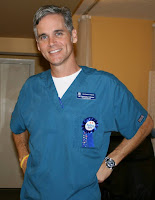The Truth About
Back Pain & Bed Rest!
Hello, Jacksonville!
Dr. Chris Renne here again - to talk to you about what works and what doesn’t
for healing back pain.
First of all, you need to understand that there are two
types of back pain: acute pain and chronic pain. Acute back pain tends to be
sharper and more localized. It usually results from injury - for example, an
auto accident. For most people, acute pain is short term. Short of a very serious injury or complications, your
pain should start getting better in a matter of days or weeks.
The other type of back pain is chronic back pain. Chronic
pain is usually less intense and more widespread than acute pain.
Unfortunately, it is often long term,
and it doesn’t always have an obvious source. In some cases, the pain begins with an injury but persists long after the
injury is healed.
When it comes to acute pain, the source of the pain is
usually pretty obvious, and so is the treatment. When your injury heals, your
pain will get better.
Chronic pain is a lot trickier, though, and experts often
disagree about the best treatment. Because of this, a lot of myths have sprung
up about treating chronic back pain. Let me put those myths to rest right now!
Myth #1: Long-term bed rest is the
best cure for back problems.
When your back hurts, you may be inclined to stay in bed and
wait it out. You may have even been told by
others that this is what you should.
It turns out, though, that long-term bed
rest will do little to help your back pain - and in fact, it might make it
worse!
Now, if you’ve suffered an injury to your back, you may indeed need to take it easy for 24-48 hours. After that, though, extended bed rest can lead to a
number of issues: your muscles can begin to atrophy, since you aren’t using
them; your heart can get out of shape too; you can experience loss of bone
density; you increase your risk of blood clots; and, perhaps worst of all, you
can wind up in an ‘illness mindset’.
A surprising amount of back pain has psychological roots.
The more you believe you are unwell, the more likely you are to feel increased
pain.
So get out of bed, because it’s time to exercise!
Myth #2: Exercise can hurt your back.
You may think that exercise might injure your back further.
But in fact, there exist low-impact
aerobic exercises that almost any patient is capable of, no matter what their
level of pain and injury. Here are some examples of low-impact aerobic
exercises:
·
Walking
·
Stationary bike
·
Elliptical trainer
·
Water therapy
See
my blog post on low-impact exercises for more
ideas. The important thing is to find an exercise that works for you, one that
you can do frequently. Prolonged exercise
in any form stimulates blood flow, which provides nutrients to your injured
back. This helps engage your body’s
natural healing process. And it has other benefits too!
People who exercise regularly
have been shown to have fewer instances of back pain and shorter episodes when
pain occurs. Exercise also release endorphins, which are the body’s natural
defense against pain. And being up, out of bed, and moving helps keep you
functioning and participating in the activities of daily living. That’s
important for having positive mindset, which is all critical for healing!
Myth #3: Surgery is the best solution for long-term back pain.
People who suffer from long-term chronic back pain are often
desperately searching for solutions. They may turn to spinal surgery as a
possible answer. In my experience, though, if you are experiencing chronic back
pain, surgery is almost never a good idea.
Surgery on your spine is extremely invasive. It is also
risky. It can take months for your
body to heal from, sometimes longer. And you may wind up worse than before,
with reduced functionality and no real change in your pain levels. Studies have
shown that for people who experience chronic back pain, surgery often has
little to no effect.
If you have an acute and recent back injury, there may be
some cases where surgery is what your doctor recommends. But this will happen
soon after the injury occurs! If you have been experiencing back pain for a
long time, I would think twice before signing up for surgery.
So how do I fix long-term back pain?
I wish there were one
simple thing I could tell all of my patients with chronic back pain to do that
would fix their pain! Unfortunately, chronic back pain is complex and not well
understood by doctors. Your best bet is to enable your body’s natural healing
mechanisms. The best way to do this is through exercise and a positive mindset!
With these two things and the aid of some
therapy, you can greatly improve your standard of living and reduce your pain.
If you’re experiencing back pain of any kind and you aren’t sure what to do about it, come in and talk
with me! Together we will figure out the right plan to get you on the road to
recovery.
Yours in health,
Christopher B. Renne, D.C.
Chiropractic Physician
Active Medical & Chiropractic
4111 Atlantic Boulevard
Jacksonville, Fl 32207
www.activechirocenter.com









